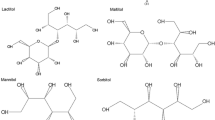Abstract
Objective
To produce an alcoholic beverage containing anthocyanins that can act as antioxidants and have anticarcinogenic activities and antihypertensive effects.
Results
High starch-assimilating sake yeast strain of Saccharomyces cerevisiae co-expressing the glucoamylase and α-amylase genes from Debaryomyces occidentalis using the double rDNA-integration system was developed. The new strain grew substantially using 5 % (w/v) purple sweet potato flour as the sole carbon source. Its cell yield reached 14.5 mg ml−1 after 3 days. This value was 2.4-fold higher than that of the parental wild-type strain. It produced 12 % (v/v) ethanol from 20 % (w/v) purple sweet potato flour and consumed 98 % of the starch content in purple sweet potato flour after 5 days of fermentation.
Conclusion
We have produced a health-promoting alcoholic beverage abundant in anthocyanins from purple sweet potato.




Similar content being viewed by others
References
Baba S, Oguri I, Fukuzawa M, Moriyama K, Lida T, Kobayashi I, Imai K (1974) Maltose assimilation by Saccharomyces sake. J Brew Soc Jpn 69:453–455
Dohmen RJ, Strasser AWM, Dahlems UM, Hollenberg CP (1990) Cloning of the Schwanniomyces occidentalis glucoamylase gene (GAM1) and its expression in Saccharomyces cerevisiae. Gene 95:111–121
Eksteen JM, van Renseburg P, Cordero Otero RR, Pretorius IS (2003) Starch fermentation by recombinant Saccharomyces cerevisiae strains expressing the α-amylase and glucoamylase genes From Lipomyces kononenkoae and Saccharomycopsis fibuligera. Biotechnol Bioeng 84:639–646
Ghang DM, Yu L, Lim MH, Ko HM, Im SY, Lee HB, Bai S (2007) Efficient one-step starch utilization by industrial strains of Saccharomyces cerevisiae expressing the glucoamylase and α-amylase genes from Debaryomyces occidentalis. Biotechnol Lett 29:1203–1208
Gietz D, Jean A, Woods R, Schiestl RH (1992) Improved method for high efficiency transformation of intact yeast cells. Nucleic Acids Res 20:1425
Kang NY, Park JN, Chin JE, Lee HB, Im SY, Bai S (2003) Construction of an amylolytic industrial strain of Saccharomyces cerevisiae containing the Schwanniomyces occidentalis α-amylase gene. Biotechnol Lett 25:1847–1851
Kano M, Takayanagi T, Harada K, Makino K, Ishikawa F (2005) Antioxidant activity of anthocyanins from purple sweet potato, Ipomoea batatas cultivar Ayamurasaki. Biosci Biotechnol Biochem 69:979–988
Kim JH, Kim HR, Lim MH, Ko HM, Chin JE, Lee HB, Kim IC, Bai S (2010) Construction of a direct starch-fermenting industrial strain of Saccharomyces cerevisiae producing glucoamylase, α-amylase and debranching enzyme. Biotechnol Lett 32:713–719
Kim HR, Im YK, Ko HM, Chin JE, Kim IC, Lee HB, Bai S (2011) Raw starch fermentation to ethanol by an industrial distiller’s strain of Saccharomyces cerevisiae expressing glucoamylase and α-amylase genes. Biotechnol Lett 33:1643–1648
Lila MA (2004) Anthocyanins and human health: an in vitro investigative approach. J Biomed Biotechnol 5:306–313
Lin LL, Ma YJ, Chien HR, Hsu WH (1998) Construction of an amylolytic yeast by multiple integration of the Aspergillus awamori glucoamylase gene into a Saccharomyces cerevisiae chromosome. Enzyme Microb Technol 23:360–365
Ma Y, Lin LL, Chien HR, Hsu WH (2000) Efficient utilization of starch by a recombinant strain of Saccharomyces cerevisiae producing glucoamylase and isoamylase. Biotechnol Appl Biochem 31:55–59
Marin D, Jimenez A, Lobato MF (2001) Construction of an efficient amylolytic industrial yeast strain containing DNA exclusively derived from yeast. FEMS Microbiol Lett 201:249–253
Nieto A, Prieto JA, Sanz P (1999) Stable high-copy number integration of Aspergillus orizae α-amylase cDNA in an industrial baker’s yeast strain. Biotechnol Prog 15:459–466
Park JY, Lee JY, Choi SH, Ko HM, Kim IC, Lee HB, Bai S (2014) Construction of dextrin and isomaltose-assimilating brewer’s yeasts for production of low-carbohydrate beer. Biotechnol Lett 36:1693–1699
Ray CR, Panda SK, Swain MR, Sivakumar PS (2012) Proximate composition and sensory evaluation of anthocyanin-rich purple sweet potato (Ipomoea batatas L.) wine. Int J Food Sci Technol 47:452–458
Saigusa N, Terahara N, Ohba R (2005) Evaluation of DPPH-radical-scavenging activity and antimutagenicity and analysis of anthocyanins in an alcoholic fermented beverage produced from cooked or raw purple-fleshed sweet potato (Ipomoea batatas cv. Ayamurasaki) roots. Food Sci Technol Res 11:390–394
Author information
Authors and Affiliations
Corresponding author
Rights and permissions
About this article
Cite this article
Lee, JY., Im, YK., Ko, HM. et al. Direct utilization of purple sweet potato by sake yeasts to produce an anthocyanin-rich alcoholic beverage. Biotechnol Lett 37, 1439–1445 (2015). https://doi.org/10.1007/s10529-015-1811-7
Received:
Accepted:
Published:
Issue Date:
DOI: https://doi.org/10.1007/s10529-015-1811-7




